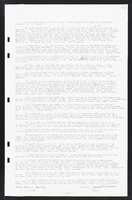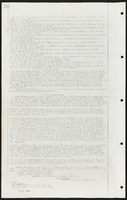Search the Special Collections and Archives Portal
Search Results
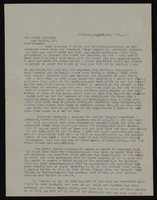
Correspondence, Levi Syphus to Sadie George
Date
1930-05-17
Archival Collection
Description
This folder is from the "Correspondence" file of the Sadie and Hampton George Papers (MS-00434)
Text
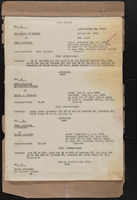
Stewart family real estate documents
Date
1920 to 1929
Archival Collection
Description
Stewart family real estate documents
Text

Transcript of interview with Marianne Carpenter by James D. Campbell, March 02, 1977
Date
1977-03-02
Archival Collection
Description
James D. Campbell interviews Las Vegas native, Marianne Carpenter (born in 1929) at the Environmental Protection Agency (EPA) office, located at the University of Nevada, Las Vegas. During the interview Marianne recalls the crash of Carol Lombard’s plane, the early above ground atomic tests, pollution and other social and environmental occurrences that have taken place in Las Vegas. Marianne also discusses the Helldorado Parade, the Downtown area and the Mesquite Club. Lastly, she offers an overview of her experience working for Nellis Air Force Base and her current job at the EPA
Text

Meeting minutes for Consolidated Student Senate University of Nevada, Las Vegas, October 24, 1991
Date
1991-10-24
Archival Collection
Description
Includes meeting agenda and minutes. CSUN Session 21 Meeting Minutes and Agendas.
Text
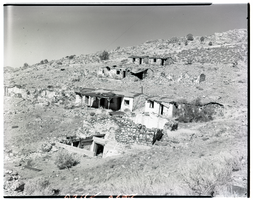
Film transparency of a ghost town, Delamar, Nevada, 1956
Date
1956
Archival Collection
Description
A view of some of the abandonded buildings on a hillside in Delamar, Nevada. One of the structures has a covered porch Delamar, Nevada, nicknamed The Widowmaker, is a ghost town in central eastern Nevada, USA along the east side of the Delamar Valley. During its heyday, primarily between 1895 and 1900, it produced $13.5 million in gold. In 1889, prospectors John Ferguson and Joseph Sharp discovered gold around Monkeywrench Wash. A mining camp was then born west of the Monkeywrench Mine. It was called Ferguson. In April 1894, Captain Joseph Raphael De Lamar bought most of the important mines in the area and renamed the Ferguson camp as Delamar. In the same year, a newspaper called the Delamar Lode began publication and a post office was opened. Soon, the new settlement boasted more than 1,500 residents, a hospital, an opera house, churches, a school, several businesses and saloons. Most buildings were made of native rock. By 1896, the Delamar mill was handling up to 260 tons of ore daily. Water for the camp was pumped from a well in Meadow Valley Wash, some twelve miles away. Supplies and materials traveled even further, by mule team over mountainous terrain from the railroad head at Milford, Utah, which was 150 miles from Delamar. Silicosis The gold in the Delamar mines was embedded in quartzite which when crushed created a fine dust. Miners breathing the dust often developed silicosis and the town became known as a "widow-maker." Many ruins now stand semi-intact in the Delamar ghost town region. Foundations can easily be seen from adjacent hills. There are two graveyards, which have been vandalized. The area is honeycombed with mines and mineshafts, but in recent years the main shaft has been blasted closed. Wild horses roam the area. The nearby dry lake is known to pilots as Texas Lake because its outline resembles the state of Texas.
Image
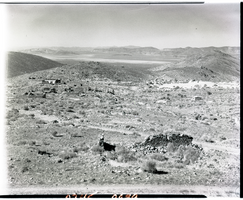
Film transparency of a ghost town, Delamar, Nevada, 1956
Date
1956
Archival Collection
Description
A view of some of the abandonded buildings in Delamar, Nevada, taken from a nearby hill. Delamar, Nevada, nicknamed The Widowmaker, is a ghost town in central eastern Nevada, USA along the east side of the Delamar Valley. During its heyday, primarily between 1895 and 1900, it produced $13.5 million in gold. In 1889, prospectors John Ferguson and Joseph Sharp discovered gold around Monkeywrench Wash. A mining camp was then born west of the Monkeywrench Mine. It was called Ferguson. In April 1894, Captain Joseph Raphael De Lamar bought most of the important mines in the area and renamed the Ferguson camp as Delamar. In the same year, a newspaper called the Delamar Lode began publication and a post office was opened. Soon, the new settlement boasted more than 1,500 residents, a hospital, an opera house, churches, a school, several businesses and saloons. Most buildings were made of native rock. By 1896, the Delamar mill was handling up to 260 tons of ore daily. Water for the camp was pumped from a well in Meadow Valley Wash, some twelve miles away. Supplies and materials traveled even further, by mule team over mountainous terrain from the railroad head at Milford, Utah, which was 150 miles from Delamar. Silicosis The gold in the Delamar mines was embedded in quartzite which when crushed created a fine dust. Miners breathing the dust often developed silicosis and the town became known as a "widow-maker." Many ruins now stand semi-intact in the Delamar ghost town region. Foundations can easily be seen from adjacent hills. There are two graveyards, which have been vandalized. The area is honeycombed with mines and mineshafts, but in recent years the main shaft has been blasted closed. Wild horses roam the area. The nearby dry lake is known to pilots as Texas Lake because its outline resembles the state of Texas.
Image

Film transparency of a ghost town, Delamar, Nevada, 1956
Date
1956
Archival Collection
Description
Some of the abandonded buildings in Delamar, Nevada. A tailing pile from one of the mines is visible in the center of the photograph. A stone structure is visible on the right side of the photograph. Delamar, Nevada, nicknamed The Widowmaker, is a ghost town in central eastern Nevada, USA along the east side of the Delamar Valley. During its heyday, primarily between 1895 and 1900, it produced $13.5 million in gold. In 1889, prospectors John Ferguson and Joseph Sharp discovered gold around Monkeywrench Wash. A mining camp was then born west of the Monkeywrench Mine. It was called Ferguson. In April 1894, Captain Joseph Raphael De Lamar bought most of the important mines in the area and renamed the Ferguson camp as Delamar. In the same year, a newspaper called the Delamar Lode began publication and a post office was opened. Soon, the new settlement boasted more than 1,500 residents, a hospital, an opera house, churches, a school, several businesses and saloons. Most buildings were made of native rock. By 1896, the Delamar mill was handling up to 260 tons of ore daily. Water for the camp was pumped from a well in Meadow Valley Wash, some twelve miles away. Supplies and materials traveled even further, by mule team over mountainous terrain from the railroad head at Milford, Utah, which was 150 miles from Delamar. Silicosis The gold in the Delamar mines was embedded in quartzite which when crushed created a fine dust. Miners breathing the dust often developed silicosis and the town became known as a "widow-maker." Many ruins now stand semi-intact in the Delamar ghost town region. Foundations can easily be seen from adjacent hills. There are two graveyards, which have been vandalized. The area is honeycombed with mines and mineshafts, but in recent years the main shaft has been blasted closed. Wild horses roam the area. The nearby dry lake is known to pilots as Texas Lake because its outline resembles the state of Texas.
Image
Pagination
Refine my results
Content Type
Creator or Contributor
Subject
Archival Collection
Digital Project
Resource Type
Year
Material Type
Place
Language
Records Classification

